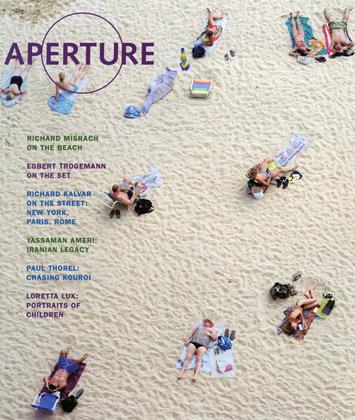NOTES
From the Editor
We open this issue on the beach, with Richard Misrach's most recent body of work. Subtly intertwining an apocalyptic vision with his trademark textured luminosity, Misrach offers us the calm before the storm.
The sea also beckons Paul Thorel, but here as the means and not the end. As he sets sail to Greece from his home in Naples, Thorel’s goal is singular: he is chasing kouroi, the ancient Greek figures that are some of the earliest sculptural embodiments of motion and “physical perfection.” Thorel, a premier innovator with digital imagery, has with his collaborators defied conventions of time and space (at least as those conventions relate to exhibitions). These “travelers from an antique land” (pace Shelley) are here manifested, as he says, through gesture, not material. Using the most contemporary technology, Thorel creates a site-specific exhibition in the extraordinary Museo Archeologico Nazionale in Naples, joining ancient and contemporary cultures in a revelatory presentation.
German photographer Loretta Lux, looking to the work of Old Master painters, also draws from history and gives it a contemporary spin. Her groundbreaking use of the computer offers a surprising take on Mannerism and other “isms” from art history’s canon, in the process providing a beautiful, disconcertingly formal vision of childhood.
It seems appropriate that in this issue—featuring much work that challenges the notion of what constitutes a photograph today—we introduce a new word into the ever-poetical lexicon of art-speak. Iranian artist Yassaman Ameri’s work is “Photoshopped” (her term); she also uses scanning and a range of other new technological approaches in her remarkable montage images. As writer Minna Proctor discusses in her accompanying essay, Ameri focuses on the forgotten women of Iran and provides them with a legacy that history did not permit.
Throughout his career, Parisbased Magnum photographer Richard Kalvar has turned his lens to fleeting scenes and corners that many others might well overlook. We present here a selection of Kalvar’s incisive— and often bitingly funny—studies of people and animals in urban settings, drawn from his ongoing project “Earthlings.” Capturing, with uncanny reflexes, the moment of human connection, the instant of meaning in geometry, Kalvar does more than watch, he sees.
Watching to the point of really seeing is Egbert Trogemann’s modus operandi as well, but he chooses as his subject television game-show studios around the world—global “nonplaces,” as he describes them—an equalizer where participants/ viewers are stripped down by media culture, and distinctions between peoples become apparent. Hearkening back to Misrach’s crowds on beaches—just waiting, watching—Trogemann invokes Goethe’s Watchman in Faust:
Oh blest are these eyes,
All they’ve seen and can tell: Let it be as it may—
They have loved it so well!
From the Executive Director
In December, Aperture Foundation’s Board of Trustees approved a Strategic Plan that charts our course for the next three to five years. You will be happy to know that the quality of magazine production will be strictly upheld, as we increase our commitment to new and emerging artists. We do not intend to be “trendy,” but rather to embrace Aperture’s history of discernment and innovation. There will also be more articles and reviews by non-U.S. contributors.
Elsewhere at Aperture Foundation, we will be launching an educational program made up of lectures, symposia, and panel discussions on all aspects of photography. These events will be free, organized in collaboration with museums and other nonprofit photography organizations, and will take place in major cities, starting with Los Angeles, San Francisco, Seattle, New York, and London. We will send separate notice of these events to those of you who live nearby.
 View Full Issue
View Full Issue
More From This Issue
-
 Photographer's Project
Photographer's ProjectMoments Distilled: Photographs By Richard Kalvar
Spring 2004 -
 Work In Progress
Work In ProgressOn The Beach: Photographs By Richard Misrach
Spring 2004 -
 Archive
ArchiveMaking History Yassaman Ameri
Spring 2004 By Minna Proctor -
 Work And Process
Work And ProcessLoretta Lux's Changelings
Spring 2004 By Diana C. Stoll -
 Roads Less Traveled
Roads Less TraveledChasing Kouroi
Spring 2004 By Paul Thorel -
 On Location
On LocationFrom Watching To Seeing: Photographs By Egbert Trogemann
Spring 2004 By Egbert Trogemann
Subscribers can unlock every article Aperture has ever published Subscribe Now
Editor's Note
-
 Editor's Note
Editor's NoteEditors' Note
Spring 2000 -
 Editor's Note
Editor's NoteImmagini Italiane
Summer 1993 By Con Amicizia -
 Editor's Note
Editor's NoteAperture
Summer 1987 By The Editors -
 Editor's Note
Editor's NoteSelf And Shadow
Spring 1989 By The Editors -
 Editor's Note
Editor's NoteThe São Paulo Issue
Summer 2014 By The Editors -
 Editor's Note
Editor's NoteSounds
Fall 2016 By The Editors

